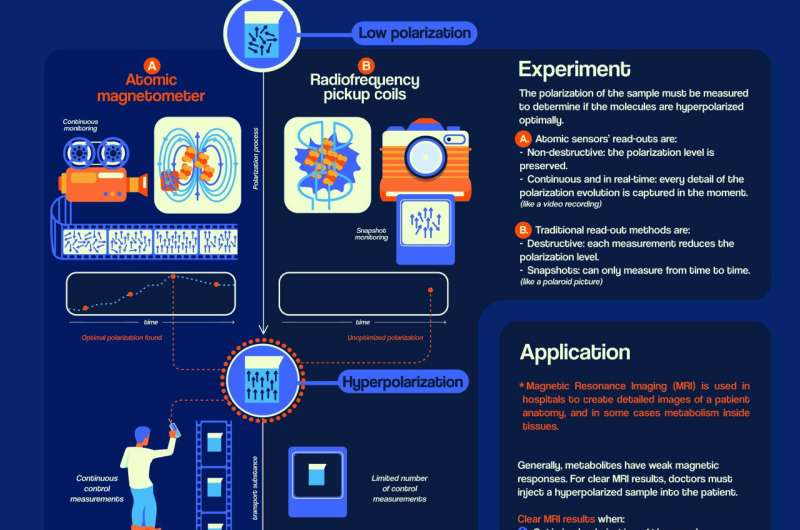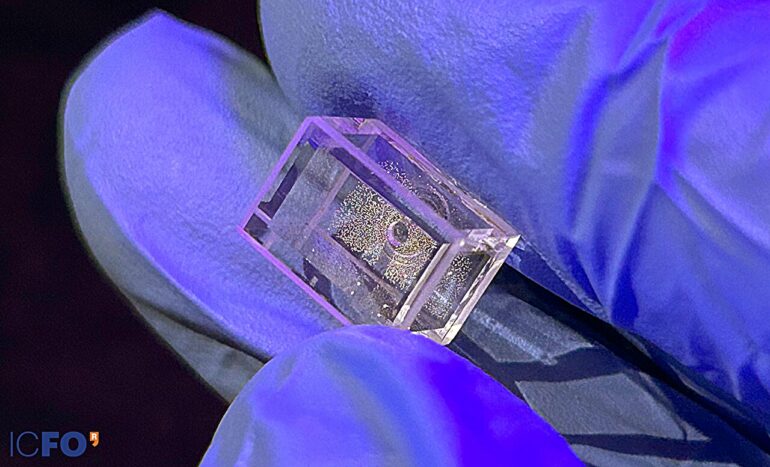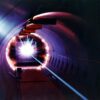Magnetic resonance imaging (MRI) has long been a cornerstone of modern medicine, providing highly detailed images of internal organs and tissues. MRI machines, those large, tube-shaped magnets commonly found in hospitals, use powerful magnets to map the densities of water and fat molecules within the body.
In addition to these molecules, other substances like metabolites can also be mapped, but their concentrations are often too low to produce clear images. To overcome this limitation, a technique known as hyperpolarization is employed to enhance the magnetic resonance signal of these substances, making them more visible during MRI scans.
Hyperpolarization involves preparing a substance outside the body in a state where its magnetization—key to creating MRI images—is near its maximum. This process can boost the signal by thousands of times compared to its natural state. Once hyperpolarized, the substance is injected into the patient and transported to the target organ or tissue. However, before this can happen, it is crucial to confirm that the substance is adequately hyperpolarized through rigorous quality control processes.
Current quality control techniques face two significant challenges. First, these methods often reduce the magnetization of the sample during the read-out process, thereby diminishing its ability to enhance the MRI scan. Second, the time required for measurement can be lengthy, during which the substance’s magnetization naturally decays, limiting the opportunity for consecutive measurements. This results in a lack of critical data that could otherwise help maximize the efficiency of hyperpolarization.
Furthermore, once the sample is hyperpolarized, there is a risk that it could lose its magnetization during transport to the MRI machine. Traditional quality control techniques, due to their time-consuming nature, may fail to detect this loss in time.
Now, a collaboration of IBEC researchers Dr. James Eills (now at Forschungszentrum Jülich, Germany) and Dr. Irene Marco Rius and ICFO researchers ICREA Prof. Morgan W. Mitchell and Dr. Michael C. D. Tayler has demonstrated how atomic sensor techniques overcome the limitations of conventional sampling when measuring the magnetization of hyperpolarized materials. This breakthrough was recently reported in the journal Proceedings of the National Academy of Sciences.
In particular, the team used optically pumped atomic magnetometers (OPMs), whose operating principles differ fundamentally from traditional sensors, enabling real-time detection of the fields produced by hyperpolarized molecules. The nature of OPMs allowed these researchers to perform continuous, high-resolution and non-destructive observations throughout the entire experiment, including the hyperpolarization process itself.
According to the authors, if the field of hyperpolarization sensing was cinema, previous methods would be like a sequence of still photos, leaving the plot between frozen pictures open to the viewer’s guess.
“Instead, our technique is more like a video, were you see the whole story frame by frame. Essentially, you can observe continuously and without resolution limits, and this way you do not miss any details,” explains Dr. Michael Tayler, ICFO researcher and co- author of the article.
Unveiled behaviors of chemical compounds during magnetization
The team tested their OPMs by monitoring hyperpolarization in clinically relevant molecules. The atomic sensors’ unprecedented resolution and real-time tracking allowed them to witness how the polarization in a metabolite compound ([1-13C]-fumarate) evolved under the presence of a magnetic field.
The atomic sensors revealed “hidden spin dynamics” that had gone unnoticed until now, offering a new path towards optimizing the hyperpolarization from the very start of the process.

Infographic Atomic Sensors. © ICFO
“Previous methods obscured subtle oscillations in the magnetization profile, which previously went undetected,” remarks Tayler. “Without the OPM, we would have achieved a suboptimal final polarization without even realizing.”
Beyond simple observation, the method could be used to control the polarization process in real-time and stop it at the most convenient point, for instance, when the maximum polarization is attained.
The study revealed other unexpected behavior when the team applied a magnetic field to repeatedly magnetize and demagnetize the hyperpolarized fumarate molecule. They expected to see the magnetization increasing to a maximum and then going back to zero over and over, transitioning smoothly from one state to the other every time. Contrary to these simple expectations, the molecule exhibited complex dynamics due to hidden resonances at certain magnetization-demagnetization durations and magnetic fields.
“This understanding will help us detect when unwanted behavior occurs and adjust parameters (like the duration of the cycle or the intensity of the magnetic field) to prevent it,” explains Tayler.
The work represents an advancement in hyperpolarized MRI technology, thanks in large part to the collaborative efforts of IBEC’s Molecular Imaging for Precision Medicine group and ICFO’s Atomic Quantum Optics group. IBEC expertise in hyperpolarization methods and ICFO’s expertise in OPM sensing technologies were critical in achieving the results.
“This is a beautiful example of the new science that can be achieved when researchers from different disciplines work together, and the proximity of IBEC and ICFO meant we were able to collaborate closely and achieve something truly novel,” acknowledges Dr. James Eills, IBEC researcher and first author of the article.
Dr. Tayler reflects on the team’s success, saying, “The OPM measurements worked beautifully from the start. The sensors’ exquisite sensitivity revealed hidden dynamics we hadn’t anticipated, as if they were meant for this purpose. The ease of use and the wealth of new information make them a powerful tool for hyperpolarization monitoring.”
Benefits for MRI and other future applications
The immediate application of this study would be to integrate portable atomic sensors into clinical sample quality control for MRI, something that is currently being implemented by the ICFO team in the Spanish Ministry Project “SEE-13-MRI.” This way, one could guide molecules to the highest possible level of polarization during hyperpolarization and reliably certify the polarization level before substances are injected into patients.
The development could significantly reduce the cost and logistical challenges of metabolic MRI. If so, this would expand its reach from the handful of specialized research centers where it is currently used, to many hospitals worldwide.
However, the potential of atomic sensors extends far beyond medical imaging. The same non-destructive, real-time tracking system using optically-pumped magnetometers (OPMs) could be applied to monitor macromolecules in chemical processes, study high-energy physics targets, or even optimize spin-based algorithms in quantum computing.
According to Dr. Tayler, “The method we’ve developed opens up new avenues not only for improving MRI but for various fields that rely on precise magnetic sensing, and we are excited about its further development.”
More information:
James Eills et al, Live magnetic observation of parahydrogen hyperpolarization dynamics, Proceedings of the National Academy of Sciences (2024). DOI: 10.1073/pnas.2410209121
Citation:
Atomic sensors unveil hidden dynamics of molecular polarization (2024, October 16)



